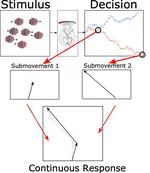MotorControl
While typically developing individuals show movements that are optimal in some way (e.g. Friedman & Flash, 2009), in individuals with motor disorders, we observe movements that are clearly not optimal. In this research area, I am developing models that are capable of producing movements that look like movements produced in motor disorders, in order to help understand the underlying causes of the movement difficulties.
Reaction times have commonly been used as a way of studying various cognitive processes. We can modify the input and see the effect on the output (e.g. it takes longer to decide if uncommon words are words compared to common words), and hopefully inform our understanding about cognitive processes. But by using arm movements rather than reaction times, we can observe parts of the process leading up to the final decision, which can provide us much more information about how these processes work. My research has involved using my background in motor control to inform these studies. We have used these techniques in studies of masked priming (Finkbeiner & Friedman, 2011) and the role of spatial frequencies in face detection (Awasthi, Friedman & Williams, 2011). I have also developed a models based on how we use partially accumulated evidence to produce these movements (Friedman, Brown & Finkbeiner, 2013). We have used this technique for study decision making under conflict in the Simon task (Salzer & Friedman, 2020).

